Falling Down The Gravity Well: Orbits of the LEGO Orrery
42179 Planet Earth and Moon in Orbit, part of the broader LEGO Space super-theme this year, is unique in a lot of ways. It’s a Technic set that does not recreate some sort of vehicle—a rarity when scanning through the roughly 500 Technic sets listed on Brickset. The mechanisms are really interesting, with five different motions from a single input. And it’s also a great teaching tool.
The technical name for the set is an orrery, which is a mechanical device used to represent the movements of the planets in our solar system. The Oxford’s History of Science Museum has a beautiful example of an orrery. Now onto the build and the science behind the set!
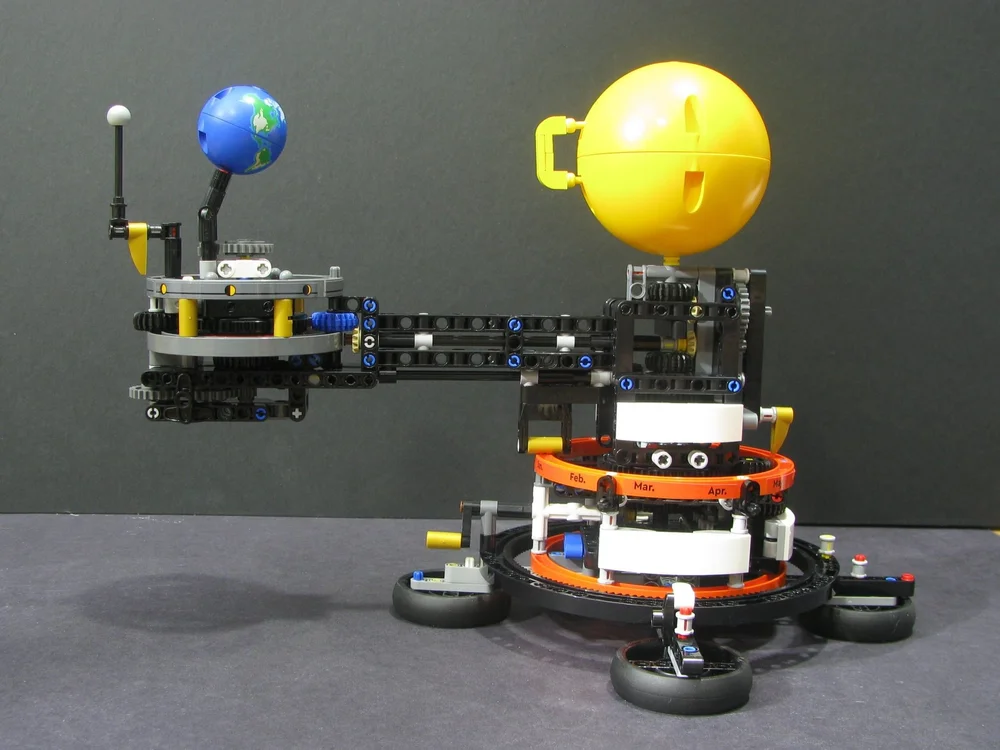
Solar Flare! Ok that’s really big scale wise, but a fun add
As established before, I am a space nerd and was very excited about this set in particular. I built this set with my 13-year-old. We don’t build a lot of sets together, and he was excited by this as much as I was. We enjoyed the build and had a great time detaching the earth mechanism and accidentally misaligning the gears, which put the solstices/equinoxes about a month out of phase (not too hard to fix).
Some of my kid’s assorted comments on the set included how he liked how the gold pieces stood out, that train wheels were utilized in the build (they help to balance the earth and moon gears), and the design for the base was clever. He thought the set could be improved by using blue pins to hold the Earth together; he would have also liked several Earths with Pangaea and other various continents printed on them (that’s my not-so-little anymore science nerd for you).
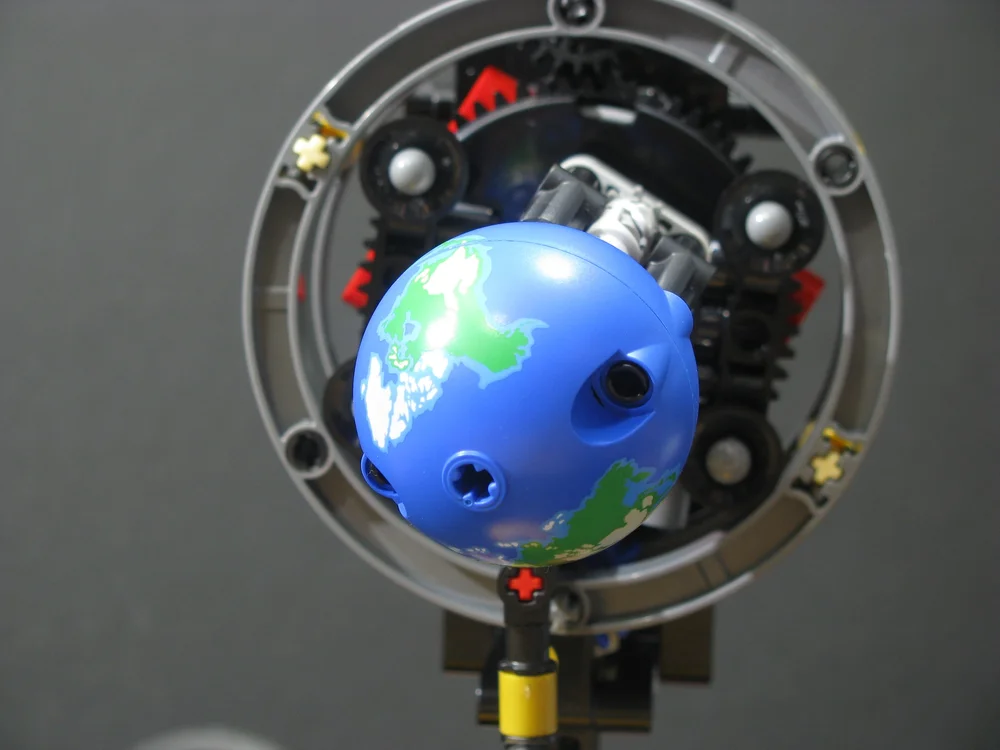
Train wheel stabilizers
Orrerys are very neat. There are more than a few made with LEGO bricks out there from creators like JK Brickworks, Chris Orchard & Brent Waller, and ROSch.
Space is Big. Like, Really Big.
No orrery is going to be a true scale model. The sun is just too big, and the distance between it and the Earth is too great. For fun, let’s attempt to create an accurate scale with this set based on the components given.

According to the table above, the Earth and Moon are pretty close in scale to each other; but the Sun is 109 times larger than we are. A sun in scale with the 5-stud diameter Earth would be 545.6 studs long! That is 14 feet (4.3m)! As They Might Be Giants sing, “The sun is a mass of incandescent gas. A gigantic nuclear furnace!”
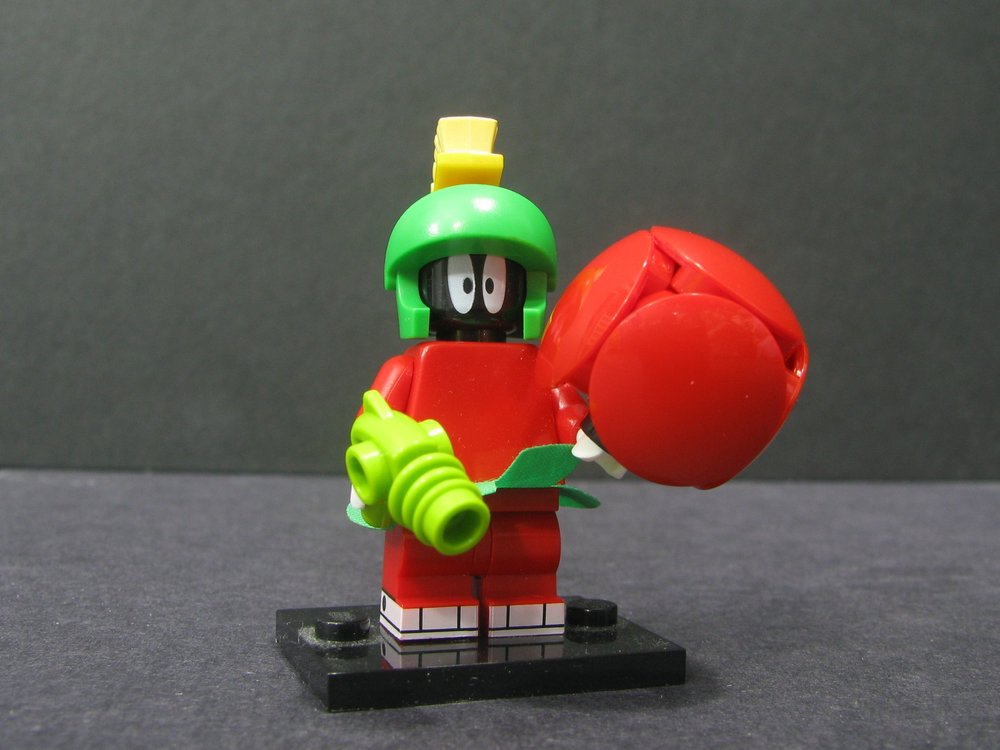
“Mmm isn’t that lovely” Marvin the Martian with Mars in scale to earth
Some other notable planet sizes based on the five-stud diameter Earth include Jupiter, which would be 56 studs in diameter, and Mars, which would be 2.67 studs in diameter. For the Sun as featured in the set, the mighty Jupiter would be a little smaller than the moon in this set!

Orbital distances are even crazier! The set has a 25-stud distance between the Sun and Earth at this scale, and the moon would be a mere 0.06 studs away from the Earth. Venus could be accurately modeled at 18 studs from the Earth; Saturn would be 238 studs away; and Neptune would be 893 studs away from the Earth. That’s a long way!
Things get downright insane if we scale it for the moon’s distance in the set. The Earth would be 2,724 studs away (70 ft / 21 m); Neptune would be a whopping 81,837 studs (0.4 miles / 0.64 km). As you can tell, space is really, really big.

Long exposure!
Outside of true, accurate scaling, there are a few other things that an orrery cannot easily do. Orbital inclination is the measure of an object’s orbit around a major celestial body For example, the moon is at a 6° inclination, which is why eclipses are uncommon and not always at the equator. Most planets are less than 3°, with the exception being Mercury at 7° and Pluto at 17°.
Eccentricity (e) can be thought of as how far off a conic section is from being circular. Circles have e=0 - as they are perfect circles and do not deviate from that. Ellipses (the shape of most planetary orbits) have an 00.2.
Interestingly, Earth’s aphelion (the point in orbit farthest from the Sun) and perihelion (the point in orbit closest to the Sun) trail the solstices by about two weeks. On July 5, 2024, we will be the farthest from the sun in our orbit and swing through perihelion on Jan 4, 2025.
Grinding Gears
In my limited experience with Technic sets, it is sometimes hard to appreciate the mechanism as you build it, and this set is no exception. It is the nature of the beast, and it makes modifications more difficult to achieve. Fortunately, the set has minimal plating to hide the inner workings of the orrery. I ventured into Studio for the first time to digitally build just the relevant gears and axels. My humble first attempt left something to be desired, but it illustrates things well enough. (Here’s a Studio tip that I found out too late: you can import the parts from a set!).
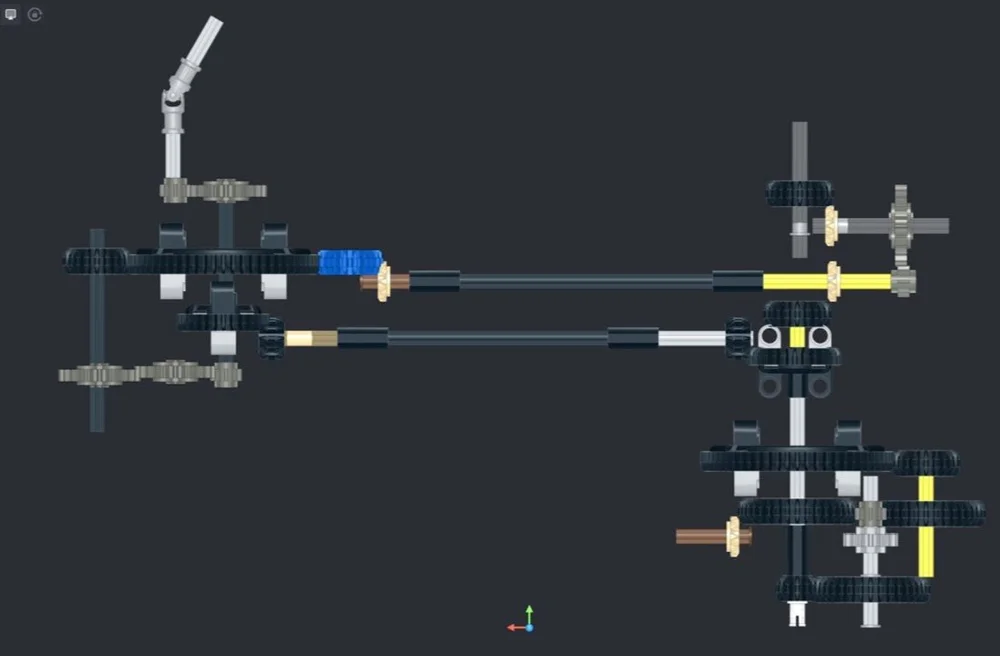
In the images below, I have the gear ratio in full teeth count by each gear pair; on the bottom right are the reduced ratios multiplied together for the final total ratio. General gear ratios are reduced to X:1 or 1:X, with the exception of the day calculation. I left the ratios as integer pairs as it is more quickly read in my opinion.

The gear train that spins the sun is the least complicated of the five, it consists of four pairs of gears and results in a 9:1 ratio. When compared to the other gear ratios, this makes for a 27-day rotation for the sun, which is in the correct range; but as shown below, the sun does not rotate as the solid body would and has different rational speeds based on latitude!

he Sun rotates on its axis once in about 27 days. This rotation was first detected by observing the motion of sunspots. From NASA.gov
The year train is the dense cluster of gears in the base of the set. The front view I’ve chosen, and the solid red color perhaps doesn’t do this system justice since you lose the 16:16 pairing, and the 8-tooth gear does appear to be attached to both 36-toothed gears.
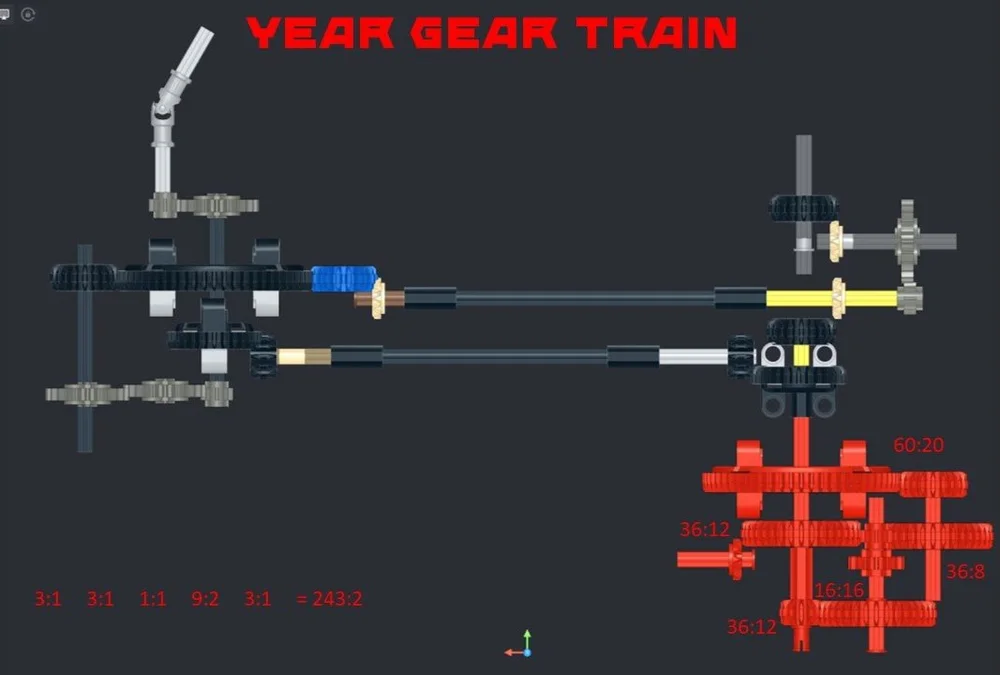
However, lots of interesting things are happening here. We gear up substantially in this area to 243:2! Through a series of smaller gears driving larger gears, we get a result of 121.5 cranks of the input gear to drive the earth around the sun once.

The moon train builds on the sun train. It also winds up with a 1:9 ratio, which, when factored by the earth train’s 1:3, gives the moon a 27-day orbit which is right at the correct 27.3-day orbital period!
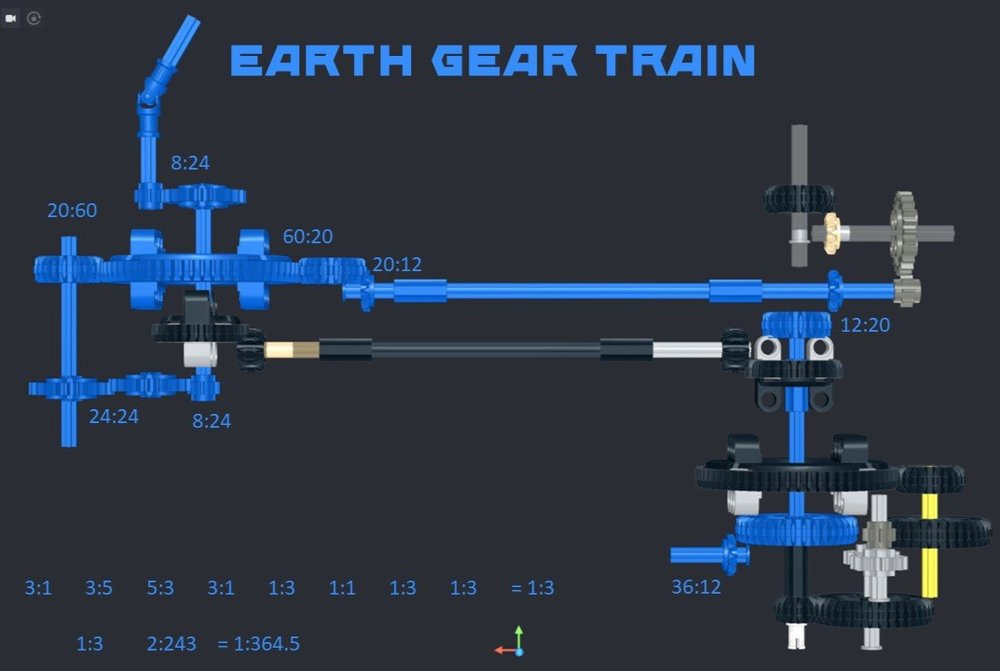
The Earth gear train plays the long game by reducing the moon train’s input by a third, generating three days for every turn of the input crank. Three days per turn of the input, when combined with the year train’s 121.5 turns per year, results in 364.5 earth revolutions per orbit. That’s not too shabby and pretty close to 365.2X days that we experience in a year. Also, considering that 5 and 73 are the only factors of 365 and both are prime, getting exactly to a precise day count was going to be a challenge, and a 0.2% error is pretty good!
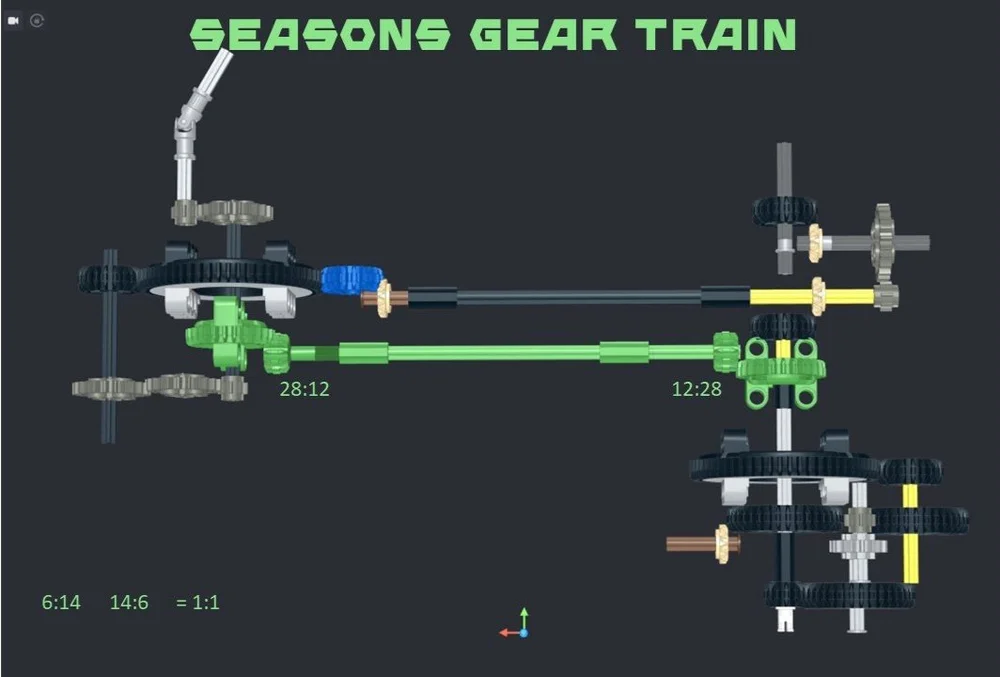
Only four gears make up this seasons gear train, and it took me a bit to figure out just what was going on. The turn table in the pedestal is fixed as the arm rotates around the 12-tooth gear at the same speed as the arm, which in turn rotates the earth in its seasonal tilt. This is about the only gearing you can “mess up”. I didn’t fully appreciate the clocking schematic at step 203, so pay attention there!
That’s No Moon
I really enjoy building 42179 Planet Earth and Moon in Orbit. It was fun to create, and I will get lots of use out of it. If you’re a science teacher in any way (from schools, scouts, summer camps, astronomy clubs, or even being that one person who explains eclipses to their friends), you cannot go wrong adding this set to your teaching tool box.
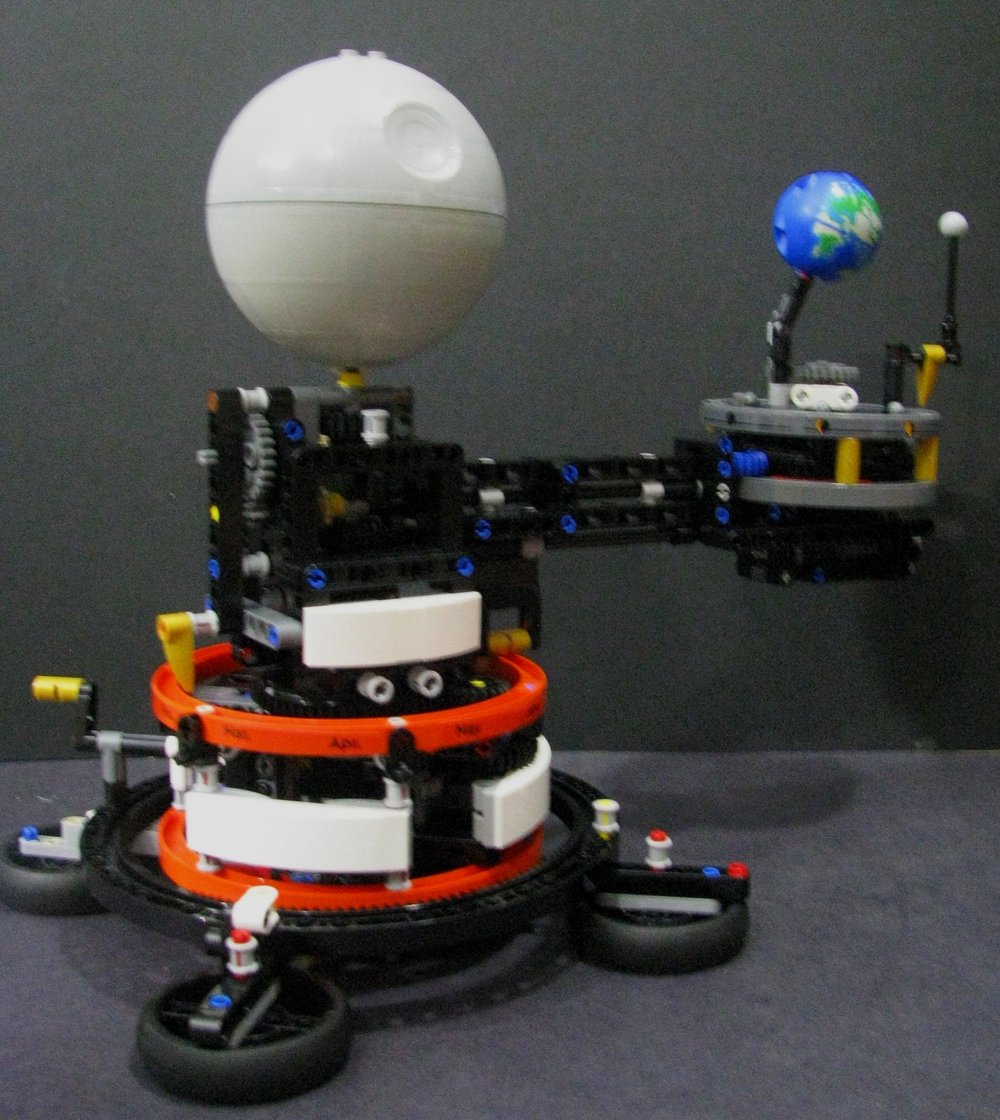
That’s no sun! The star wars planet series are the same diameter as the sun in the set. Lots of mod possibilities with that as an option!
Yes, $75 US is a little high for a Technic set of this size, but I think it is worth it. The set is well thought out, and the gearing to get rotations and orbital periods right is fantastic, especially considering the limitations of the LEGO gearing system. I hope you enjoy this set as much as I do!
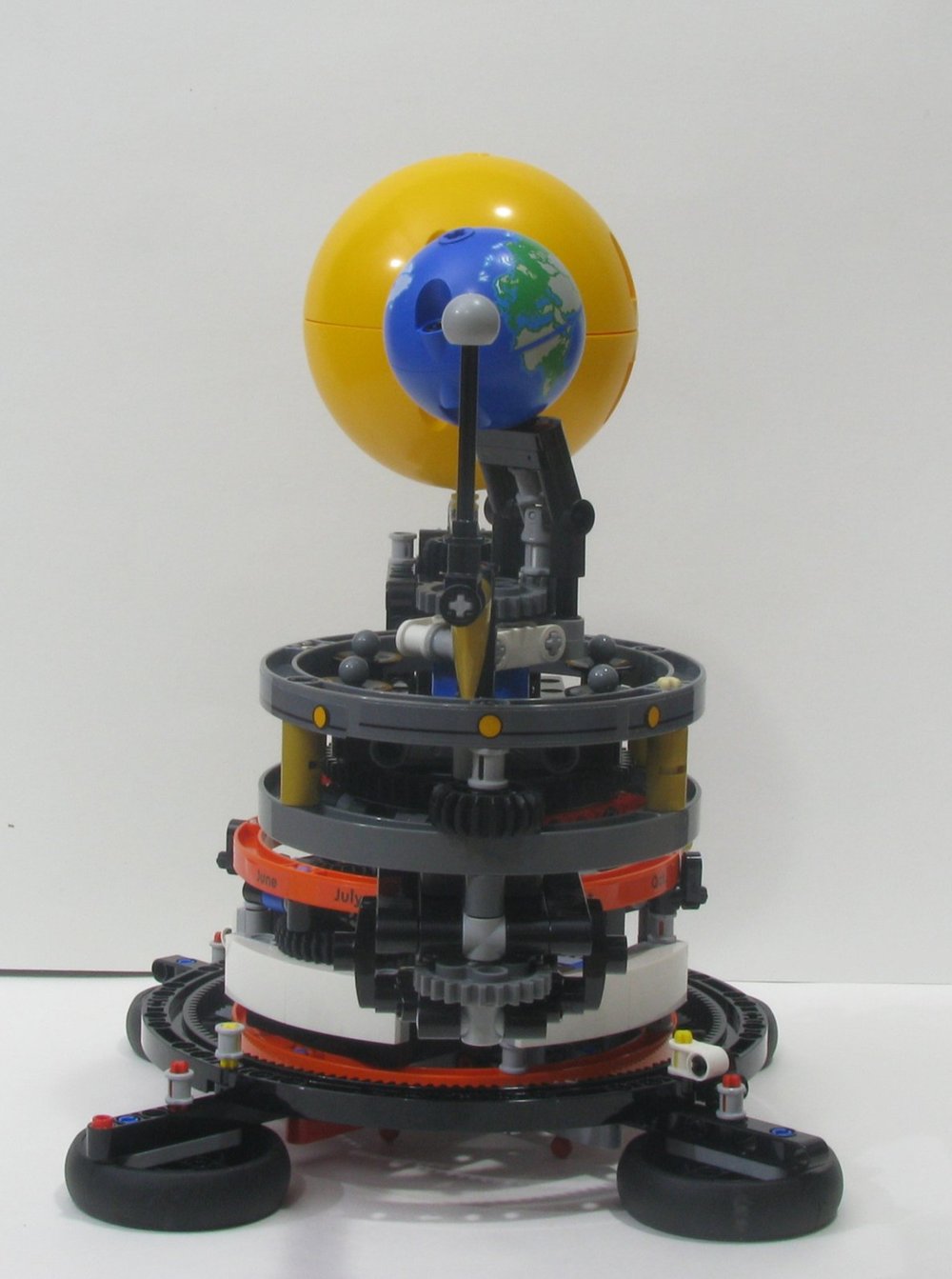
All orbital values mentioned in this article were sourced from the following references unless another source is noted:
Spacecraft Mission Design, 2nd Ed by Charles D Brown, AIAA Press, 1998
Fundamentals of Astrodynamics by Bate, Mueller, and White, Dover Books, 1971
DISCLAIMER: This set was provided to BrickNerd by LEGO. Any opinions expressed in this article are those of the author.
What other non-vehicle objects would you like to see in Technic? Let us know in the comments below.
Do you want to help BrickNerd continue publishing articles like this one? Become a top patron like Charlie Stephens, Marc & Liz Puleo, Paige Mueller, Rob Klingberg from Brickstuff, John & Joshua Hanlon from Beyond the Brick, Megan Lum, Andy Price, Lukas Kurth from StoneWars, Wayne Tyler, Monica Innis, Dan Church, and Roxanne Baxter to show your support, get early access, exclusive swag and more.

